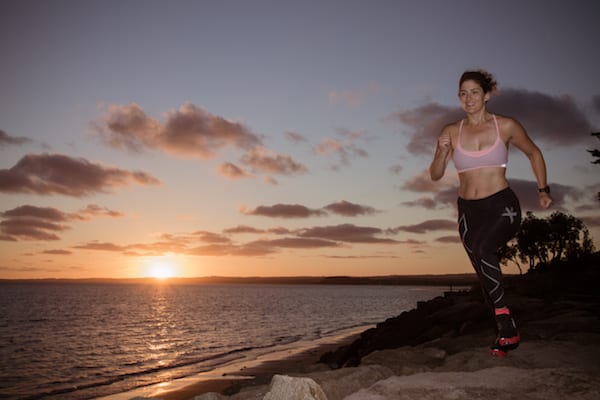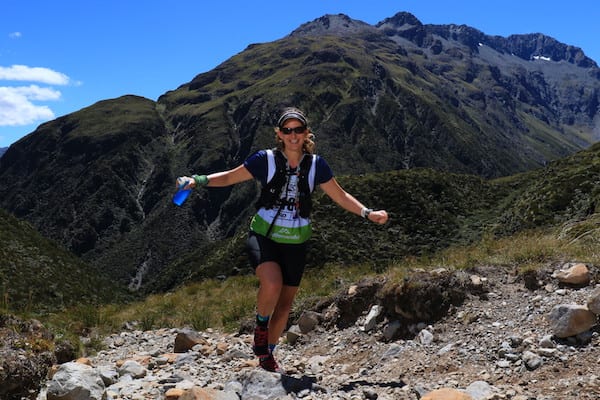Years after starting a career, having three kids and chasing the ‘mature life’, Dr Rowan Brookes realised she had lost her adventurous spirit. So she sought to find it, by racing from one side of New Zealand to the other. Here’s what she learnt along the way.
The dawn had just broken and the sky was still lingering with a delicate pale rose hue. Behind me I could hear the waves of the Tasman Sea greeting the shore of the West Coast. The air had a palpable intensity created by the 300 people who surrounded me. To my side a woman quietly cried. I assumed that, like me, she was overwhelmed with the emotion of the moment. The sharp shot of a cannon firing rang out across the shoreline and the competitors surged forwards across the sand and rocks.
This was the start line of the Coast to Coast 2018 and it was time to swallow my self-doubt and begin two days of an epic adventure traversing 243 km from the West Coast to the East Coast of the South Island in New Zealand. To reach the finish line I’d need to run across a mountain pass, negotiate 70 kms of white water by kayak and come face to face with a legendary headwind on the ride to the finish line.

I still remember everything about the day I first heard about the race.
It was 20 years ago and I was in the middle of my first big adventure, cycle touring down the Sound Island of New Zealand with a friend. We spent days talking about how incredible it would be to complete such a race, but at the time I never thought that it could be me lining up on the start line. The event just seemed too long, too hard and far too technical. Not long after that cycle tour, I went to university, started a family, got married and began my career. That youthful, adventurous and risky spirit of mine was buried deeply amongst the practicalities of the quest for a ‘mature life’.
Over the last three years, I’ve learned that living an adventurous life is a rich opportunity for both personal and professional growth. By racing the Coast to Coast, I came face to face with my self-limiting beliefs and learned five important lessons.
Tackle a goal that seems impossible
A worthy adventure should be future-focused, where success is uncertain. If we orientate ourselves towards aspirational goals that seem impossible, the measure of success won’t be just the final outcome: the adventure will be everything that is accomplished along the way. In this way, time becomes more than the passing of days, it is filled with meaningful learning experiences to draw upon.
When I decided to undertake the Coast to Coast, there was a great deal of uncertainty and the goal seemed entirely impossible.
First, I had to convince my husband to support me while I undertook the huge training schedule.
There was the minor issue that I didn’t know how to kayak or road ride, nor did I have the associated equipment for these sports.
Finally, there was the enormous expense of travelling to New Zealand and completing the race.
There were many times like this when I doubted that I’d actually make it to the start line, but through each barrier I seemed to find a way and gradually make progress.
Prioritise by letting go of things
Time and savings are not things that I have in abundance.
I’m a mum of three kids, who works in a full-time academic role, with a husband who travels up to 50% of the time and a 2.5 hour commute everyday. Most modern families I know are faced with similar challenges, so this is nothing extraordinary. By the time the peak training period hit for the Coast to Coast, I was training for about 13 hours per week, on top of all of my other responsibilities.
To be able to prepare myself adequately for this adventure, it was necessary to let things go.
During the lead up to the race, I stopped trying to be everything for everybody. When invitations rolled in for work-related networking functions over Christmas, I said no to every single one of them. I also let go of some my usual high standards and accepted that good enough is sometimes okay. By letting things go, I was able to make time for the things that really mattered in my life and made sure that I worked to a standard I was proud of.
Spend time in your comfort zone
Although I crossed the finish line of day one, I spent most of the first day feeling like I was failing. When you ride with a bunch it’s up to 30% more efficient, so I knew that the most effective way to tackle the first cycle 55 km would be to find a good bunch and ride with them.
It’s pretty safe to say that I did everything wrong in this section of the race. I was quickly dropped from the bunch I started with, spent far too much time riding by myself and used all the wrong hand signals. As a result, when I reached the first transition area I felt miserable.

I felt like I’d sold myself short through my training. I’d shied away from joining a local riding group to learn how to ride in a bunch because I was afraid that if I did join a ride, that I’d not be able to keep up. My fear of failure in the lead up to the event had only magnified when the heat was on.
As a trail runner, I thought the 30.5 km run would be the stage of the race that I was most comfortable. Instead, I headed out from the transition feeling physically and emotionally spent. Shortly into the run, I turned to link arms with another woman at one of the many river crossings. I realised that she was the woman who’d helped me during a section of the ride. She and her team member warmly welcomed me.

There is a lot of hype around stepping outside of our comfort zones.
I too have a mantra about regularly being outside of my comfort zone, because I recognise it’s a fertile ground for growth. However, too much time outside the comfort zone is a recipe for fatigue and emotional overload. It’s important to spend time in our comfort zones to nourish, reflect, feel safe and draw the learnings from our experiences. The security, sisterhood and positivity that these women offered to me, as we picked our way up the rocky river beds and boulders of Deception Valley, was the security blanket I needed to regain the mindset to head off on my own again.
Don’t fear what may never happen
To reach the finish line on the final day I had to cycle 15 km, kayak 70 km and finish with another 70 km cycle. In the lead up to the race, I’d had sleepless nights concerned that I might actually die in the rapids during the kayak section. During my training, I’d only been able to practice four times on whitewater. I woke up on the second day of the race worried I’d experience a repeat of the first cycle stage.
I’d travelled to the event with a friend who’d been faster than me on day one, so I was expecting him to race ahead again in day two. It turns out we really needed each other throughout the day. About 5km into the kayak he picked the wrong line in a series of rapids and tipped out of his boat. Thankfully, he was quickly able to self-rescue aided by the Coast to Coast team and start kayaking again.
Our inexperience on similar rivers meant we were underdressed and with the freezing water temperature, he quickly started shivering uncontrollably and his motor function was clearly declining. We pulled the kayaks off the river and I helped him into warm dry clothes. From then onwards we stayed within eyeshot of each other for the rest of the day.

After six hours of paddling, we turned a corner and the majestic Waimakariri Gorge Bridge signaled the end of the kayak stage. Tears overcame me as I realised that I’d managed to complete the kayak stage without falling out, injury or certain death. Rather than looking at what I had accomplished during my training (3-5 hours per week of kayaking), I’d spent my mental energy preparing for the worst, to the extent that my insecurities had almost paralyzed me. I learned that I shouldn’t fear the unknown. Even the most daunting tasks are possible, particularly if they’re aided by preparation, teamwork and a never give up attitude.
Leaning on other people is encouraged
After the kayak we quickly jumped on our bikes ready to start the final stage. We could see a group tantalisingly close in front of us and knew that with the intense headwind that joining them would be hugely beneficial. We decided to push to reach them. My friend would take the lead pushing as hard as he could. I’d do short 10 second stints at the front so he could recover and push again. At the end of two days this was all I could manage at the speed we were riding. In the end, it took us 25 km of riding the hardest I’ve ever done to finally gain on them.
Working with my training partner throughout day two taught me the invaluable lesson of leaning on other people. While I’d felt fabulous offering my support after he’d fallen out of his kayak, I was embarrassed that I couldn’t take the load of the headwind for longer than 10 seconds. There was so many times during this ride that I wanted to drop back and wait for the next bunch, but I knew he needed me to make the bunch ahead. The tiny contribution that I was able to make was pivotal to our final success. I’ve been so used to throwing myself fully at a task as the major contributor that it felt totally alien to be the weakest cog, yet still be a vital player. Moving forward, I’ll be more confident in my myself and my ability to bring my skills and experiences into the equation, no matter how small.
Crossing the finish line was a rush of emotion, gratitude and disbelief. To complete an impossible goal which I’d held onto for 20 years was one of the most rewarding, rich and life-affirming things that I’ve done.
Buried under the household chores, endless school notices and work responsibilities, I’ve found my lost youthful spirit and I don’t think I’m going to lose it again.


